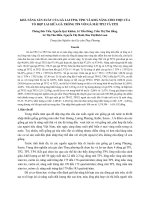TP1
Bạn đang xem bản rút gọn của tài liệu. Xem và tải ngay bản đầy đủ của tài liệu tại đây (630.04 KB, 41 trang )
Introduction to XML
Chapter 1
Core XML / Chapter 1 / Slide 2 of 35
Chapter Objectives -1
Discuss markup language
List and explain drawbacks of HTML
Discuss the architecture of XML documents
List the benefits of XML
Discuss Parser
Core XML / Chapter 1 / Slide 3 of 35
Chapter Objectives -2
Build a complete XML Document:
Character Data
Comments
Processing Instructions
Entities
General Entities
Parameter Entities
The DOCTYPE Declarations
Core XML / Chapter 1 / Slide 4 of 35
History of Markup
Documents recorded
using paper and pen
Typesetters formatting
documents
Tools used by typesetters
to format a document
Core XML / Chapter 1 / Slide 5 of 35
Markup Language
A Markup language defines the rules that help to add
meaning to the content and structure of documents.
They are classified as:
Stylistic Markup – It determines the presentation of the
document
Structure Markup – It defines the structure of the
document
Semantic Markup – It determines the content of the
document
Core XML / Chapter 1 / Slide 6 of 35
SGML
Generalized Markup Language (GML) is
the system of formatting documents.
GML was fine-tuned and came to be known
as Standard Generalized Markup Language
(SGML).
SGML is the source of origin of all markup
languages
Core XML / Chapter 1 / Slide 7 of 35
Features of SGML
It describes markup language, which allows
authors to create their own tags that relate
to their content.
It needs a separate file that will contain all
the rules for the language, for its
interpretation
A SGML application is markup language
derived from SGML.
Core XML / Chapter 1 / Slide 8 of 35
HTML
HTML is the most famous markup language
derived from SGML.
It was created to mark up technical papers so that
they could be transferred across different platforms
for the scientific community.
It is now also used by those non-scientific users
who are concerned about their document’s
presentation.
Core XML / Chapter 1 / Slide 9 of 35
Drawbacks of HTML
Fixed tag set
Presentation technology does not relate to the
contents
It is flat
Clogging
HTML is not international
Data interchange is impossible
Does not have a robust linking mechanism
HTML is not reusable
Core XML / Chapter 1 / Slide 10 of 35
HTML and XML code Examples
<UL>
<LI> TOM CRUISE
<UL>
<LI> CLIENT ID : 100
<LI> COMPANY : XYZ Corp.
<LI> Email :
<LI> Phone : 3336767
<LI> Street Adress: 25th
St.
<LI> City : Toronto
<LI> State : Toronto
<LI> Zip : 20056
</UL>
</UL>
<Details>
<CONTACT>
<PERSON_NAME>TOM CRUISE
</PERSON_NAME>
<ID> 100 </ID>
<Company>XYZ Corp. </Company>
<Email> </Email>
<Phone> 3336767 </Phone>
<Street> 25th St. </Street>
<City> Toronto </City>
<State> Toronto </State>
<ZIP> 20056 </ZIP>
</CONTACT>
</Details>
HTML Code
XML Code
Core XML / Chapter 1 / Slide 11 of 35
XML -1
XML stands for Extensible Markup Language.
It overcomes all the drawbacks of HTML.
It allows the user to define their own set of tags, and
also makes it possible for others (people or programs)
to understand it.
It is more flexible than HTML.
It inherits the features of SGML and combines it with
the features of HTML.
It is a smaller version of SGML.
Core XML / Chapter 1 / Slide 12 of 35
XML -2
XML is a metalanguage and it describes other
languages.
The data contained in an XML file can be displayed
in different ways.
It can also be offered to other applications for
further processing.
Style sheets help transform structured data into
different HTML views. This enables data to be
displayed on different browsers.
Core XML / Chapter 1 / Slide 13 of 35
XML Architecture - 1
XML supports three-tier architecture for handling
and manipulating data.
It can be generated from existing databases using a
scalable three-tier model.
XML tags represent the logical structure of data
that can be interpreted and used in various ways by
different applications.
The middle-tier is used to access multiple databases
and translate data into XML.
Core XML / Chapter 1 / Slide 14 of 35
XML Architecture -2
Core XML / Chapter 1 / Slide 15 of 35
XML – A Universal data format
HTML is a single markup language, but XML is a
family of markup languages.
Any type of data can be easily defined in XML.
XML is popular because it supports a wide range of
applications and is easy to use.
XML has a structured data format, which allows it
to store complex data
Core XML / Chapter 1 / Slide 16 of 35
Benefits of XML
The three-tier architecture has easier
scalability and better security.
The benefits of XML are classified into the
following:
Business benefits
Technological benefits









